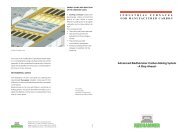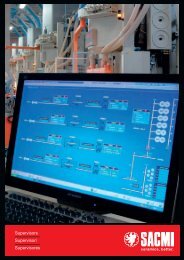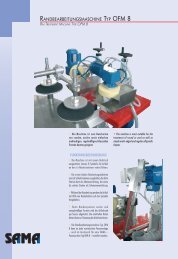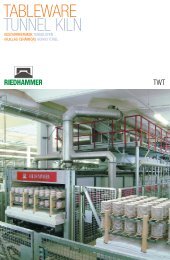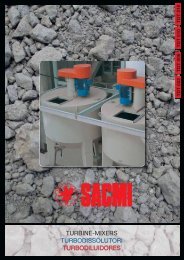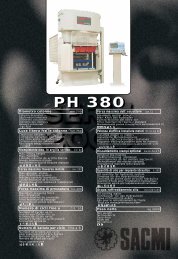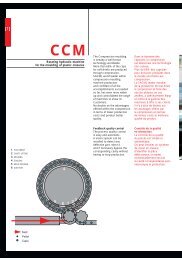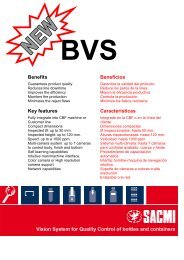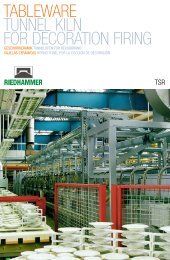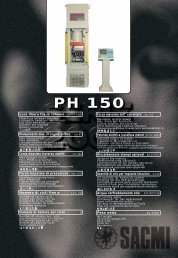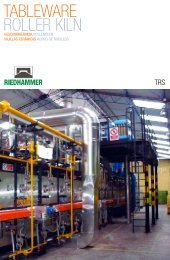Innovative Treatment of Ceramics Using Low O2 ... - Sacmi
Innovative Treatment of Ceramics Using Low O2 ... - Sacmi
Innovative Treatment of Ceramics Using Low O2 ... - Sacmi
Create successful ePaper yourself
Turn your PDF publications into a flip-book with our unique Google optimized e-Paper software.
Fig. 8 • Schema <strong>of</strong> a debinding zone for a tunnel<br />
kiln<br />
plant. Thus the gases loaded with hydrocarbons<br />
are led to increasing temperatures so that, with a<br />
correspondingly low oxygen concentration, most<br />
<strong>of</strong> them already burn up in this zone. The gases<br />
flow to the thermal postcombustion section via<br />
the chimney installed between the debinding<br />
and the preheating zone. In the thermal postcombustion<br />
system any residual hydrocarbons<br />
are burnt up completely by means <strong>of</strong> a controlled<br />
thermal treatment. Not even condensates can<br />
deposit in the waste gas piping due to the high<br />
temperature. The clean waste gases from the<br />
thermal postcombustion process are led back to<br />
the kiln and, supported by special burners, serve<br />
the direct heating <strong>of</strong> the debinding zone.<br />
These special burners acting as injectors for the<br />
gases from the thermal postcombustion are used<br />
to control the temperature in the debinding<br />
zones <strong>of</strong> the plant as well as the oxygen atmosphere<br />
in these zones. The oxygen measurement<br />
with the incorporated control guarantees constant<br />
low O 2<br />
atmo sphere conditions throughout<br />
the process. The system thus ensures safe operation<br />
outside the explosive limits. The large gas<br />
circulation volumes in the kiln channel create<br />
good uniform temperatures and constant atmospheric<br />
concentrations.<br />
The basic principle <strong>of</strong> the debinding system described<br />
and represented schematically in Fig. 8<br />
has meanwhile become established. It stands out<br />
for its low energy consumption, safe operating<br />
mode and low waste gas losses with a minimum<br />
environmental load limited to the CO 2<br />
particles<br />
which cannot be avoided during the combustion<br />
<strong>of</strong> fossil fuels.<br />
With tunnel kilns based on this principle, the<br />
duration <strong>of</strong> the total thermal treatment can be<br />
reduced by 50–70 % compared to conventional<br />
technology. Other excellent advantages consist<br />
in correspondingly smaller, space-saving plant<br />
sizes with lower investment costs.<br />
References<br />
[1] Locher, C., Pfaff, E., Schulz, P., Zografou, C.:<br />
Untersuchungen zum Ausbrennen organischer<br />
Substanzen im keramischen Scherben.<br />
Keram. Z. 34 (1982) [7] 361–364<br />
[2] Becker, F.: Debinding processes – physical<br />
and chemical conclusions and their practical<br />
realisations. cfi 83 (2006) [5] E2–E13<br />
[3] Ferrato, M., Cartier,T., Baumard, J.F., Coudamy,<br />
G.: Der Bindemittelabgang in keramischen<br />
Scherben. cfi/Ber. DKG 71 (1994)<br />
[1/2] 8–12<br />
[4] Ziegler, G., Willert-Porada, M.: Schadst<strong>of</strong>freduzierung<br />
durch Prozessoptimierung bei<br />
der thermischen Zersetzung organischer<br />
Additivsysteme für die keramische Formgebung<br />
unter Einbeziehung der Mikrowelleneinkopplung.<br />
Report to research project no.<br />
12068 N<br />
[5] Fuß, O.: Ermittlung und Berechnung der<br />
Sauerst<strong>of</strong>fgrenzreaktion von brennbaren<br />
Gasen. Dissertation des Fachbereichs Chemie,<br />
Universität Duisburg-Essen, Mai 2004<br />
Received: 10. 12. 2008<br />
New on the Market<br />
Partnership Between Siti-B&T<br />
Group and Nuova Fima<br />
Siti-B&T Group and Nuova Fima, two global<br />
leaders in the ceramics machinery sector, have<br />
signed a partnership which concerns a specific<br />
production process, the “end <strong>of</strong> line”.<br />
The strategic collaboration is born from the wish<br />
<strong>of</strong> both companies to supply the market with top<br />
technologic solutions on the whole range, making<br />
the most <strong>of</strong> the experience, the perfections<br />
and the extremely high product specialisations<br />
<strong>of</strong> both groups.<br />
The innovative sorting line Dynamic Synthesis is<br />
the first result <strong>of</strong> the new partnership, created<br />
from a tight collaboration which seen Siti-B&T<br />
Group and Nuova Fima work together, and also<br />
includes an engineering, assistance and after<br />
sales service. The commercial policy decided by<br />
the two companies will contribute to improving<br />
the product <strong>of</strong>fer.<br />
The new sorting line is in complete conformation<br />
with the current market demands, equipped with<br />
mono stacker with dynamic assignment system<br />
and it boasts a highly reliable packing system. It is<br />
equipped with Nuova Firma hardware and s<strong>of</strong>tware<br />
and tested electronic equipment.<br />
Dynamic Synthesis will be proposed by Siti-B&T<br />
Group for all new complete plants equipped with<br />
the adequate specifications (sizes from 15 cm ×<br />
15 cm to 60 cm × 60 cm), while Nuova Fima will<br />
propose the machine directly to its ceramic clients.<br />
New MICROMATIC System<br />
for Cerámica Rioboo<br />
The Cerámica Rioboo brickworks <strong>of</strong> Pravio (A<br />
Coruña) is the last – but not least – brickyard<br />
opting for solid fuels in Spain.<br />
This Galician producer <strong>of</strong> hollow bricks will<br />
count in the next weeks with a solid fuel firing<br />
system model MICROMATIC that will use petroleum<br />
coke as the main fuel in the kiln, for an<br />
output <strong>of</strong> approx. 250 tm/d. The fuel used in the<br />
preheating zone will be natural gas.<br />
Beralmar has already supplied more than 200<br />
solid fuel (petcoke, coals, etc.) firing systems<br />
over the last quarter <strong>of</strong> century, the half <strong>of</strong> which<br />
have been installed in the last 8 years alone.<br />
Such boom in the use <strong>of</strong> solid fuels is not just<br />
explained by the price increases <strong>of</strong> gas and heavy<br />
oil, but also by the existance <strong>of</strong> adequate technologies<br />
for their consumption, which are constantly<br />
updated.<br />
Vol. 58 (2009) [1] 15



